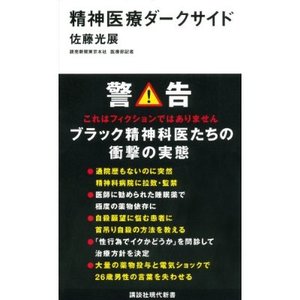Book Coverage
WARNING
This is not fiction
Some alarming truths about the dark side of psychiatrists

The Dark Side of Mental Health
By Mitsunobu Sato
Published: Kodansha
Top of Page
Severe withdrawal symptoms following prescriptions from an “authority in dizziness”
Next, let’s introduce the story of Mr. Wayne Douglas who first came to Japan with an interest in Japanese culture at age 25. He worked at various government organizations as a Coordinator for International Relations, and as an English teacher, in many places throughout Japan including the Kyushu, Chubu, and Tohoku regions.
In May 2000, when he was working at The Saitama International Association, he was struck with a severe bout of vertigo. He says “It was like my whole environment was spinning round and round”. He underwent tests at a hospital but the symptoms continued with ongoing nausea etc. He somehow managed to continue working but his concentration levels were being affected.
A month later, he was examined by a doctor who was profiled on television as being an “authority in the treatment of dizziness”. He was given the diagnosis of “Sylvian Aqueduct Syndrome” and was told that it would be necessary to change his constitutional makeup by using a course of drugs.
Going to his appointed dispensary (despite medical practices not being allowed to appoint drug dispensaries) he was given 3 kinds of benzodiazepines (Rivotril, Contol, Grandaxin) which were all mixed together in powder form with each combined dose being dispensed in individual sachets. The clinic in question continued to repeat the same prescriptions as a specially prepared “benzo-pack”. Furthermore, he was prescribed Tofranil, which is a tricyclic antidepressant, and Ketas which is said to be used for improving blood circulation.
Mr. Douglas asked the doctor whether or not these drugs have any side-effects, but he was told “These are non-addictive drugs in small doses with little side effects so you needn’t worry about taking them over long periods of time”.
As shown in the survey results discussed previously, most benzodiazepine type drugs are prescribed by psychiatrists, but that is not to say other medical practices don’t pose any problem. Probing more into the less obvious cases of prescription drug dependent people (those not associated with psychiatry), it becomes clear that the number of prescriptions from general practitioners is also on the rise. In particular, Depas (thienodiazepine) type drugs are being prescribed by general practitioners in large amounts.
Soon after Mr. Douglas began taking the prescribed drugs, he noticed a settling in his symptoms. He felt reassured and continued with the prescriptions. However, about 2 months later, his condition began to deteriorate to the point where his symptoms became worse than what they were originally, back in May.
Top of Page
Panic attacks that didn’t exist originally
In October, he was suffering from ongoing unsteadiness, like being drunk 24/7, and emotional instability including panic attacks, confusion etc. that didn’t exist before the drug treatment.
He eventually lost faith in the doctor and attempted stopping the drugs in November. Then he was overcome by fear and anxiety with the panic attacks occurring more frequently and other symptoms suddenly worsened as well. He had no alternative but to reinstate the drugs. However, even whilst continuing with the prescriptions, the panic attacks continued to worsen which affected his ability to work, and thoughts of suicide had entered his mind.
In March 2001, Mr. Douglas returned to New Zealand in a totally emaciated state. He was in such bad condition that even his own mother didn’t recognize him when she went to pick him up from the airport.
He was diagnosed by a specialist drug rehabilitation facility as suffering from benzodiazepine addiction and underwent a withdrawal program there. After 2 months he was able to break free from the drugs, but his fight with withdrawal symptoms continued. It took over 1 year for the chronic anxiety, depression, panic attacks etc to settle to the point where his doctor was able to declare him fit enough to return to the workforce.
“Even years after stopping the panic attacks continued. There was also a great deal of loss brought about as a result of the prescribed drugs.” Mr. Douglas says with regret.
Having doubts about the diagnosis he had received in Japan, Mr. Douglas began researching into Sylvian Aqueduct Syndrome. After consulting numerous specialists in New Zealand, and informing them of his original symptoms at the time of onset, he was advised that his original complaint was most likely caused by vestibular neuronitis (inflammation of the nerve in the inner ear) and not Sylvian Aqueduct Syndrome.
Mr. Douglas felt “The truth about what actually happened needs to be clarified” and with that in mind he returned to Japan in 2005. He then visited 3 different medical facilities, including a well known university hospital, where they too supported the vestibular neuronitis diagnosis. Furthermore, all the doctors, from both New Zealand and Japan, were all in agreement that benzodiazepines would not have been an appropriate means of treatment for either of the diagnoses regardless.
In 2006, Mr. Douglas made arrangements to summon the prescribing doctor, and the hospital he was employed by, to mediation in an effort to seek compensation. However, this ended without settlement, and in 2007, he lodged a judicial case at the Tokyo District Court.
The doctor denied Mr. Douglas’s claim of benzodiazepine dependency and instead claimed that he had a pre-existing case of autonomic nervous disorder. The doctor made his case by arguing that if a state of dependence had formed during the treatment, tolerance would have developed resulting in the need to periodically increase the dosage amounts; however, the doses remained the same, so there could not have been any dependency.
In response to this argument, the doctor from the drug rehabilitation facility in New Zealand indicated that Mr. Douglas had tolerance-withdrawal (withdrawal symptoms that appear whilst still taking drugs due to lost drug effect from tolerance) and that he was clearly dependent. However, this opinion was not upheld and Mr. Douglas lost his case in the Tokyo District Court, and his claim was again dismissed by the Tokyo High Court in 2011.
With regards to the possibility of dependence to prescription drugs, the Tokyo High Court decided “this cannot be recognized as established medical knowledge in our country”. However, when Mr. Douglas was prescribed the drugs in 2000, prescription drug dependency was already recognized worldwide, but once again, Japan’s unique practices had resulted in the doctor being saved.
Top of Page
Patients making a medical translation for doctors and specialists!?
Mr. Douglas, who sought justice in the courts, may have lost his case, but his belief in what he’s doing remains unperturbed. Without making a return to New Zealand, he teamed up with Mr. Tanaka and translated the Ashton Manual making a complete Japanese version, whilst continuing to scrape by from day to day teaching English part time.
He is now establishing a website which includes detailed information about his case and comments from Prof. Ashton in both Japanese and English. He is also writing a book based on his experiences.
Mr. Douglas says “The courts gave priority to protecting the doctors and medical establishments, and in doing so, failed to protect society”. The only way to create positive change is to continue with providing accurate information to the public.
In translating the Ashton Manual, both victims, Mr. Tanaka and Mr. Douglas, essentially ended up doing the doctors’ jobs for them. The two of them have shared their thoughts, as an epilogue at the end of the translation titled “In Closing of Japanese Translation”.
Top of Page
The Ashton Manual
In August 2012, The Ashton Manual in Japanese was established and made public over the internet. The Ashton Manual is a handbook which is used worldwide for the purpose of withdrawing from benzodiazepines.
The manual was written by Heather Ashton (International authority in benzodiazepine addiction from the University of Newcastle upon Tyne in England) and is based on her experiences of running a withdrawal clinic. It covers indications for use, side-effects, withdrawal symptoms, how to reduce etc. With the completion of the Japanese version, it can now be accessed in 11 different languages.
Top of Page
Japanese version made by victims of irresponsible prescribing
Prof. Ashton wrote The Ashton Manual in 1999 and she has continued to make it available over the internet whilst adding some revised additions. At first, it was only available in English, but there was a lot of interest from patients around the world, and subsequently, the number of different language translations has continued to increase. There were some people in Japan who had successfully used this manual in the past to break free from their drug regimens, but the language barrier proved to be a significant hurdle.
Enter Mr. Ryo Tanaka from the Kinki District and Mr. Wayne Douglas (translator and English teacher from New Zealand) who jumped at the opportunity to do the translation. Both of them experienced being subjected to long-term prescribing of benzodiazepines in Japan, suffered from dreadful withdrawal, and ignorance from their respective doctors. They maintained close contact with Prof. Ashton from overseas as they progressed with the translation. The Japanese medical editing was carried out by Dr. Hirokuni Beppu (neurologist) who is Chief Editor of “The Informed Prescriber” and others. Their work was done entirely on a volunteer basis.
Top of Page
Words of thanks from around the world
Let’s hear from Prof. Ashton. With the help of Mr. Tanaka and Mr. Douglas, I was able to conduct an interview with Prof. Ashton. I would like to ask that you use this information in conjunction with The Ashton Manual.
Top of Page
Approx 10,000 downloads in first week of publication
Download numbers of The Ashton Manual in Japanese had reached approximately 10,000 within the first week of being publically released. The number of patients who printed it out, and took it along to their psychiatrists became quite prevalent. Reports of some seemingly alarmed and irritated psychiatrists reprimanding their patients by saying such things as “What are you looking at that for?” and “Getting into things like that just causes problems” began to flood in. Some cases also unfolded where psychiatrists seemingly prejudged the Ashton Manual and criticized their patients in a rather autocratic and intolerant manner.
But who were the ones who created the situation where patients need to rely on The Ashton Manual in the first place? Who were the ones who sent the patients into a riptide to drown in a sea of addiction without a life raft, and then sat idly by and watched? For the drowning patients The Ashton Manual is like small life ring that has finally been thrown into the water. Isn’t it only natural that they are trying to cling onto this?
Among some of the patients, there may be some who overreact and make certain claims for damages. There may be some who mistakenly claim symptom reemergence as being due to withdrawal. However, if there had always been proper informed consent with regards to adverse effects at the first consultation, and if there had always been due consideration given to the term of treatment etc, patients may not have even ended up in a situation that may cause them to overreact. I wish to see a more sincere response from psychiatrists.
Top of Page

The primary language of this website is English. Japanese appears as translations only (except for some original court documents).
These translations have been done by many different translators including me. Therefore, there are differences in quality and styles.
Please understand that I am not native Japanese and subsequently there are parts that may sound unnatural in Japanese.

Some parts of this website still have not been translated into Japanese. If anyone (native Japanese) would like to help on a volunteer basis, please contact mentioning the part you would like to translate. Thank you.

This website has been constructed by me personally for the purpose of raising awareness about doctor induced benzodiazepine drug dependency and litigation problems.
The purpose of this site does not include any form of retribution. Also, for privacy reasons the defendants’ names along with certain other names have been omitted from all public documentation contained herein.
There are no other persons / parties involved and it in no way represents any organization or activist type movements.
It is not intended as medical or legal advice – please see Disclaimer.
According to The International Narcotics Board 2010 Report, Japan has the highest average consumption rate of “anxiolytic” benzodiazepines in Asia with the only exception being Iran (See Figure 20 on page 35).

Although use for this indication is lower than in many European countries, Japan has the highest average consumption rate of “sedative-hypnotic” benzodiazepines in the world with the only exception being Belgium (See Figure 26 on page 39).
The Ashton Manual contains expert advice on benzodiazepines and how to withdrawal written by world renowned expert Prof. Heather Ashton.

The withdrawal schedules provided in the manual are only intended as "general guides". Each person's experience of withdrawal is unique and the course of withdrawal depends on many factors.







